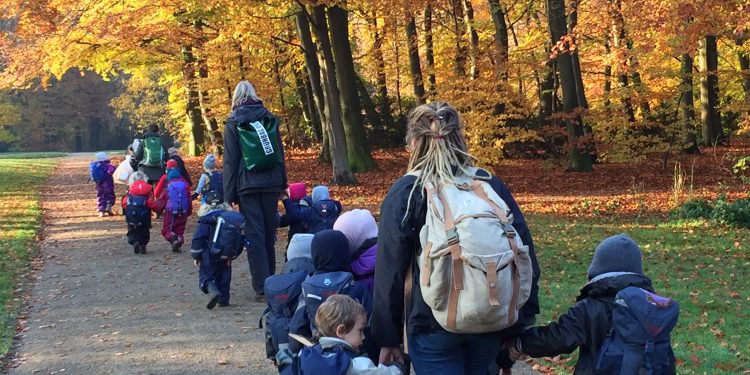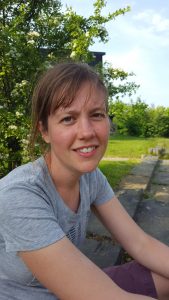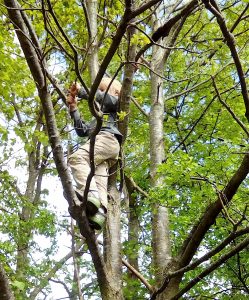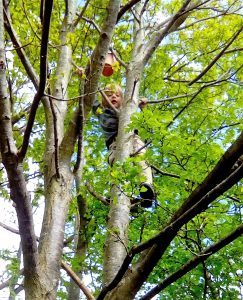Adjusting to Danish early education – a challenging experience says an American Mom

An American mom sends her two little sons off to school in Denmark and discovers that there are plenty of lessons to be learned from Scandinavia’s early childhood education, involving also field trips, fires, knives, and of course riding their bicycles to school.
The article continues below.
I will be forever thankful that my children got a taste of childhood at its finest, its messiest, and its (calculated) riskiest.
That they learned to love dense bread and leverpostej, that they climbed to the highest tree branches, that they rode their bikes to school in sun and rain and snow and wind and hail, and that we didn’t give up after that first traumatic (from my then four-year-old’s perspective), guilt-ridden (from my perspective) field trip.
That we went— at times questioningly, at times reluctantly— along for the ride, and in doing so, learned to push our own culturally defined boundaries.
The article continues below.
By Regan Quick-Severin Pictures:Private / Niels Henrik Lindegaard, Bente D. Knudsen
This morning my five-year-old son, riding his bicycle, rounded the corner of a path that winds its way through our co-housing community, then abruptly braked and looked back at our house. He found me waiting at the window to wave goodbye.
He lingered a bit longer than usual, so I opened the patio door and called out, “Goodbye! I’ll see you when you get back from the zoo!” That three-letter word reminder had him speeding away once more, catching up with his dad, anxious to get to børnehave (that is, preschool, though literally translating into ‘kindergarten’) for his field trip to the Copenhagen Zoo, about 30 kilometres away.
To get there, they might take a chartered bus, or perhaps they’ll walk to a nearby bus stop, catch a local bus to the train station, take the train into the city where they’ll catch another bus to get within walking distance of the zoo. I honestly don’t know.
Any American parent who happens to catch this article, feel free to raise an eyebrow at my indifferent ignorance of this fact.
It’s supposed to be a beautiful day in what has been a string of warm, sunny, beautiful days. But practically speaking, it could have been a cold and rainy day, and nothing I’ve described would be different.
He would still be making his way to preschool on bike (albeit in rain clothes) and there would still be that trip to the zoo. In fact, they could very well have decided to make this trip in January.
As a matter of fact, if you were to wander the streets on any given day in any given small town or big city in Denmark, chances are good that you would spot a double line of hand-holding preschoolers making their way on foot to a park, a bus stop, the library, a zoo, heck, maybe even a pet store to pick up some more fish food for the class pet.
Tomorrow, he and some others in his class (these are often not class-wide trips) are scheduled to walk to some sports fields to play there instead of in the børnehave playground, for a change. Last month, he went to the children’s science museum.
I can’t remember what and how many little walks and field trips he might have taken in between.
But that same American parent who raised an eyebrow at me earlier will likely nod in sympathy as I tell the story of the first time I came face-to-face with the reality of the Danish way of field trips here and field trips there, field trips, field trips everywhere!
The article continues below.
The American Way
We had just moved to Denmark two months earlier and my older son, who is now eight, had just turned four. He had been in børnehave for eleven days. He obviously didn’t speak any Danish yet and as such, preschool mornings were difficult (though by afternoon pick-up, it was hard to convince him to leave).
Overwhelmed enough already, I was not attuned to relying on the weekly classroom schedule taped to the wall, written in Danish, for knowing what to expect each day. That morning in late April, as we were dropping his one-year-old brother off at the nursery end of the preschool, the nursery teacher said,
“There is a trip planned to Copenhagen today. Your little one was going to stay here, but there are a lot of absences today so now everyone will go, and [turning now to my older son] I think you’re going too!”
Simultaneously I was thinking, ‘How cool is that?!’ and ‘Oh no!!’, because there was no time to build this trip up in his mind, to prepare him for anything out of the ordinary. I immediately started trying, in my own, somewhat misguided (and ultimately unsuccessful) way, to head off any resistance by him to this trip. ‘Hey, that sounds fun! A trip to Copenhagen!’
We walked to his side of the preschool and every other kid in his class was already sitting lined up against the wall, winter hat donned, backpack over winter coat (weather does not play a part in field trip planning because Danish weather refuses to live within the bounds of predefined seasons).
We were late. Typically, (in our preschool, at least) there’s no fixed start time to the day. An exception is made, I learned that morning, for field trip days.
The article continues below.
They loaned him a backpack and water bottle and on our small walk to the bus (‘Hey look! It’s a big, fancy tour bus!’), he held tight to my hand.
My attempts to make it sound like a great, fun adventure (because, wasn’t it?) amounted to nothing. Even though travelling by bus (and by train) was new and fun (it was not until later that riding in a car, which we do not own here, became the novelty for our kids) he was not impressed.
As I guiltily pried him off me so one of his teachers could carry him up onto that beast of a bus, he was crying and shaking his head and yelling, ‘No, mama! No!’ And I am thinking, ‘Where was the permission slip? Why is there no 50-kroner fee? Are they really taking 30 kids to the zoo without a single parent-chaperone?! And how exactly is my and everybody else’s one-year-old going to be securely strapped to the seat of a tour bus?’
But I asked none of these questions out loud. I felt a little in awe of a country that would so nonchalantly brush aside the values we Americans hold so dear—liability and the release therefrom… accounting for and doing away with every possible danger… emergency contact information.
I also felt a little like I was throwing my sons to the wolves and crossing my fingers that they were tame. Hoping that my children wouldn’t somehow become victims of a careless system that hadn’t fully grasped the importance of dotting every i and crossing every t.
Four years later, I still have some of the awe, but none of the fear. He and his brother made it safely back from that trip and from countless trips after.As an American living in Denmark, this seemingly spontaneous ‘get-out-and-go’ attitude with a bunch of one- to five-year olds is, well… almost unheard of.
It isn’t that you can’t search out a U.S. preschool that takes its charges on weekly romps through the city, but let me tell you about our experience with U.S. preschool field trips, which I think is more typical: two years in a row in mid-fall, we signed the permission slip and paid the fee for the annual trip to the pumpkin patch.
Parents and parent-chaperones were given their instructions and reminders. That trip was anticipated in our house for weeks. And it would have been listed on the school calendar that was made available prior to the school year even beginning.
Now it’s probably the Danish parents who are raising their eyebrows, because I can guarantee you, none of this sounds out of the ordinary to parents of preschoolers in the U.S.
For so many complicated reasons, that’s the way it usually goes in the States (think private, expensive preschools in the U.S. with an emphasis on early “education” vs. public, subsidised preschools in Denmark with an emphasis on play, as one such reason).
The article continues below.
Fires, Knives, and Trees— what you find here, not there
It’s not simply the quantity and mode of (and reasons behind) taking field trips that make Danish public preschools and elementary schools different from those in the U.S.
The other day my eight-year-old asked me, ‘Why don’t they teach kids to make [camp] fires at schools in the U.S. and why don’t they trust them to use knives?’ He’s been thinking a lot about U.S. schools lately because now, after four years, we are making our way back to the States.
I suppose you would call him a first grader (though in the U.S. he would now be a second grader). He’s attending a Danish public school (folkeskole), and he’s in ‘first class’ (he likes to joke that he and his classmates can sit in the first class train compartments). When we move back to the U.S. he will likely, because of his age, be entering the third grade.
So far, most of his knowledge of the workings of U.S. schools comes from the Captain Underpants book series (‘Mom, why do kids always get sent to the principal’s office in the United States?’ ‘Mom, why does cafeteria food always taste so gross’?), so there will be a learning curve, and there will be differences.
Differences we won’t even be aware of until we’re back and in the thick of things. But I can fairly confidently predict that he will not be making campfires during school hours and there will be no whittling and no chopping of food with sharp knives as part of a lesson on healthy eating, not even in the third grade.
Other things— he will be graded on his academic performances, he will have homework, he will change classmates every year (something he’s nervous about), he probably won’t be invited to every single birthday party.
And yes, he may very well be sent to the principal’s office occasionally (especially if he’s picked up the habit of throwing around English swear words so commonplace in the coat rooms and playgrounds of Danish schools with nary a disapproving look from adults within hearing distance).
To my five-year-old who, in Denmark, would have had another year of preschool under his belt before entering zero class, the Danish equivalent to U.S. kindergarten, I can say assuredly that he will not be allowed to climb to the highest branches of the trees.
More likely, there will be no trees at all in kindergarten for our little climber to climb. And if he tries to climb to the very top of the play structures, which he is likely to do, he will probably be told to please come down, “We do not use the playground equipment that way. You could get hurt”.
Rainy days will be spent indoors, children’s lunches will not include dense, dark rye bread and leverpostej (liver pâté), five-year olds will be expected to read and if he does not catch up quickly he will surely be invited to attend summer school or receive some other type of intervention.
The article continues below.
No freedom in the land of the free
The likelihood of learning a foreign language beginning in first grade is slim (this is when Danish children begin to learn English), and no matter the age, biking to school may equate to risky behaviour.
But let me update that last sentence. I just checked the elementary school handbook for the district they will likely be enrolled in, and it says elementary students (grades K-6) are not even permitted to ride their bicycles to school, no exceptions! Wow. My jaw just dropped wide open.
As a parent living in the United States, I will very likely never again encounter the scenario where I go to pick up my child and am met with a carefree shrug that they don’t know where he’s at, or perhaps learn that my five-year-old, who has been given permission to play outside with two or three other children without an adult present, decided to climb over the school fence (though to his credit, he climbed right back).
I can’t say that I will exactly miss these specific experiences, but I can tell you now that I will lament the lack of freedom my children will encounter in the States in comparison to what they’ve had here in Denmark.
I will raise an eyebrow at the overly cautious, overly secure bubble in which we try to raise our children in the U.S.
And I have already begun to question the wisdom of not trusting our young ones with trees, sharp knives, campfires, and now I must add, bicycles, because, as my eight-year-old pointed out, then we will never learn to be safe around fire and knives.
Of course, that is not entirely true. But parents in the U.S. have to make choices about these things.
A concerted effort has to be made to unwrap some of those protective layers for the sake of, not only adventuring and experiencing all the potential delights and thrills of childhood, but also our children (not just their well-meaning parents) learning to calculate and manage risk and the boundaries they are and are not willing to cross.
The article continues below.
Going home. Now what?
How successful will I be at allowing my children valuable and, dare I say, risky opportunities once we’re back in the U.S.?
Well, that’s another thing we will only know once we’re there in the thick of things, in the moment when opportunity comes knocking and we have a choice of whether to open the door or keep ourselves locked safely inside.
Because maybe the reason I don’t put up a fuss when my child is out on the playground without adult supervision or when I’ve not given my explicit, written permission for them to put my kids on public transportation and take them into the capital, is because, in a sense, Denmark has set up its entire society and infrastructure to act as a safety net for my children to experience adventure and freedom, to take risks, to bike, walk, climb, and bike some more— nine months of crummy weather notwithstanding.
While we’re still here, I encourage my eight-year-old to bike home from school or to friends’ houses alone, to go and buy butter or onions at the nearby farm store at five o’clock for me because we’ve run out and I need them for dinner (though sending him to the larger grocery store further from home when he was seven to go looking for a pineapple is a story I chalk up to an ‘I-as-the-parent-wasn’t-ready-for-that-adventure’ life lesson) because I fear (or know) that in the U.S. I, or perhaps society, won’t let him do these things.
Because that’s the flip-side: it’s not simply a matter of U.S. parents wanting to keep their children safe more than Danish parents do (because what Dane does not want to keep his or her child safe?), it’s that our rules, norms, and even laws and judicial system in the U.S. are set up to a) describe all possible risk and b) minimise, if not prevent it altogether.
That’s a huge system for a parent to push against, especially as it probably is safer in a number of ways for children to have their freedom over here in Denmark as compared to in the U.S. (think a higher proportion of children moving around and playing unattended in Denmark, and therefore practising risk management on a regular basis and the safety that comes in numbers; drivers looking out for bicyclists; and bike paths most everywhere).
The article continues below.
Life lessons vs academic ones
I also finally get it, this thing about pushing versus not pushing our very young children academically.
It has begun to seem nonsensical to think that, in the U.S., my five-year-old—who would rather be doing any number of outdoor activities than sitting calmly in a chair—is going to be asked to sit calmly in a chair and learn to read next year, when even his older brother—who’d sat calmly through dozens of chapter books by the time he was five—didn’t learn to read until (and here I’ll ask my fellow compatriots to get those eyebrows ready) the age of seven.
For that reason, we have started thinking, reluctantly, about alternatives to traditional public school.
We have searched out schools in the area where we will be living that care about the whole child and all the different ways children learn about the world around them and their own creative potential.
Of course, this may not be a financial option for us (and it is certainly out of the question for many Americans), as private schools are often prohibitively expensive, especially when you consider that parents are often trying to save for the outrageous expenses of their children’s university educations—but that is certainly another topic for another day (and part of the reason I’m still sitting here so bummed out to read about that bicycle policy for the school district they will probably, realistically speaking, have to attend).
The article continues below.
Taking back with us what we can
No matter what happens after we land in the United States, I will be forever thankful that my children got a taste of childhood at its finest, its messiest, and its (calculated) riskiest.
That they learned to love dense bread and leverpostej, that they climbed to the highest tree branches, that they rode their bikes to school in sun and rain and snow and wind and hail, and that we didn’t give up after that first traumatic (from my then four-year-old’s perspective), guilt-ridden (from my perspective) field trip.
That we went— at times questioningly, at times reluctantly— along for the ride, and in doing so, learned to push our own culturally defined boundaries.





